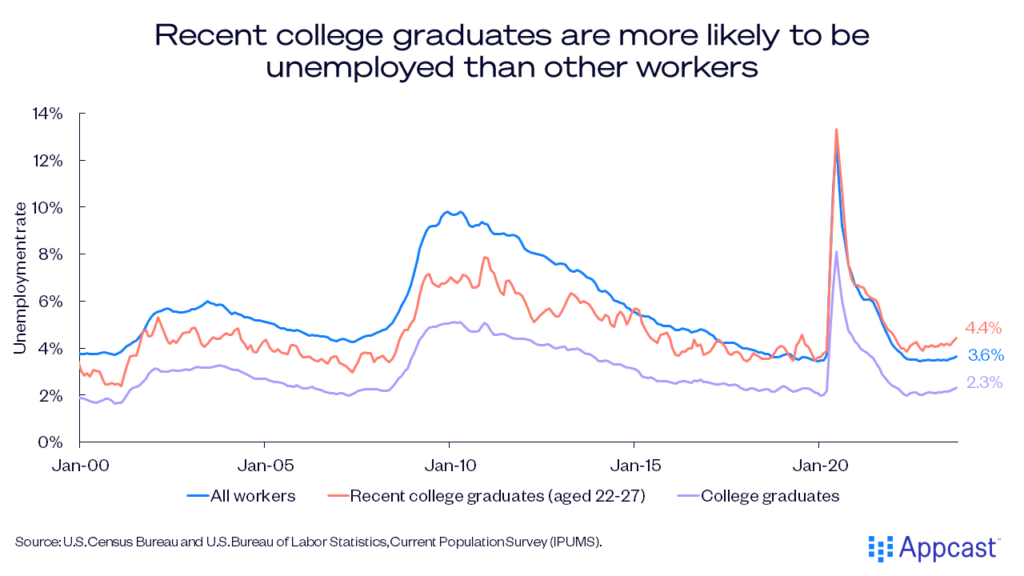Job seekers have grown more optimistic about their prospects within the past years, evidenced by the rise of trends such as the great resignation and quiet quitting. However, recent college graduates may have to face a new reality soon, as their unemployment rate is rising. Despite the robust job market, recent college graduates face greater challenges in securing employment than the rest of the population.
Recent college graduates are more likely to be unemployed than other workers
While the college-educated population has recently plateaued, there has been a consistent upward trend in completed college degrees over the past decades. In 2012, 30.9% of the population held a college degree or higher, and 87.6% had received a high school diploma. Fast forward to 2022, and these figures have increased to 37.7% and 91.2%, respectively. This is good news, as higher levels of educational attainment are closely linked to higher employment rates and have been, historically, a dependable pathway to better job prospects and higher earnings premiums. However, since the onset of the pandemic, job prospects for recent graduates have significantly deteriorated.

Preceding the COVID-19 pandemic, the labor market was notably robust, characterized by a generally low unemployment rate across all workers, including recent graduates. Now, although the overall unemployment rate has returned to pre-pandemic levels and has been under 4 percent for 24 months, there is a noticeable uptick in unemployment among recent graduates. Currently, the unemployment rate for recent college graduates stands at 4.4%, which exceeds the overall unemployment rate of 3% and is nearly double the rate for all college graduates. An increasing number of recent U.S. graduates are encountering challenges in securing employment. But what are the reasons for this development?
Blue-collar workers outpace white-collar opportunities
The U.S. job market is currently very strong. Employers added 353,000 jobs in January 2024 on a seasonally adjusted basis. But some sectors are outperforming others. Looking at blue- and white-collar job postings, blue-collar workers find themselves in an advantageous position. The growth rate for blue-collar jobs is maintaining an exceptionally high level, exhibiting a total growth rate of 19% compared to the first quarter of 2020. Particularly, roles such as driving and installation and maintenance workers are in high demand, experiencing an increase in job postings of more than 30% compared to early 2020.

Meanwhile, the growth of white-collar job opportunities – especially those that are of particular interest to recent graduates – is slowing down. Notably, professions such as software development and information design and documentation, which peaked in the first half of 2022, have undergone a significant downturn in the last two years, declining 27.4% since January 2020.

Analyzing the annual average projected job openings (for the period from 2022 to 2032) underscores a substantial demand for occupations that do not mandate higher education. According to the Bureau of Labor Statistics, the occupations with the most openings in 2023 will be fast food and counter workers, home health and personal care aides, and cashiers. Projected openings stand at 739,000, 659,000, and 613,000, respectively. Notably, even though demand is expected to decline for food preparation workers (-5%), cashiers (-10%) and retail sales workers (-2%), the most sought-after roles will be those that either require no formal educational credential or only a high school diploma.

What does this mean for recent graduates?
The overall job market exhibits robustness, but recent grads aren’t feeling the love. Despite a notably substantial increase in jobs within professional and business services last month, the highest demand persists in occupations that don’t necessitate a college degree. Looking at the broader picture, occupations that typically require a high school diploma or equivalent for entry are projected to have the highest number of openings – 7.1 million per year on average over the next decade.
Recent graduates’ positions are still not bad, but it’s more difficult for them to get a job than it is for the average worker. After all, graduates are predominantly interested in the dwindling professional occupations. These statistics highlight a mismatch between industries with the most job openings and the interests or degrees of recent graduates. Industries experiencing the most significant worker shortages, such as restaurants, hotels, daycares, and nursing homes, do not align with the preferences of recent graduates. Conversely, the industries they aspire to work in—tech, consulting, finance, media—are witnessing layoffs and reevaluating their hiring plans.
This situation could pose lasting challenges for recent graduates. If they encounter difficulties in finding suitable employment or end up in positions that do not fully utilize their skills, it can negatively impact their wages and hinder their career advancement. Psychologically, students might grapple with heightened pressure to gain work experience early on and distinguish themselves from their peers. On an economic scale, this mismatch may result in productivity losses if workers face prolonged unemployment and firms struggle to fill essential positions.
The rise of grey-collar jobs?
Considering these trends, grey-collar jobs may soon experience a surge in popularity, emerging as lucrative career options for younger workers. Grey-collar roles fall in between blue-collar and white-collar jobs, combining physical labor akin to blue-collar positions with technical skill requirements that often match or exceed those of white-collar jobs. Notably, these roles do not consistently demand a college degree. Occupations falling under the umbrella of grey-collar jobs encompass a diverse range, such as police, firefighters, teachers, childcare workers, engineers, IT professionals, nurses, and various health professionals.







